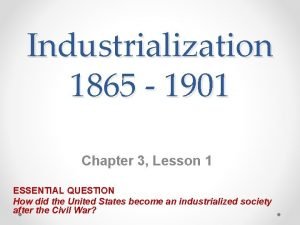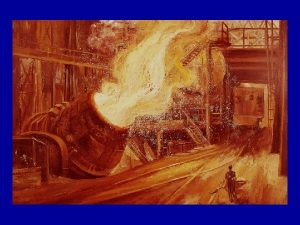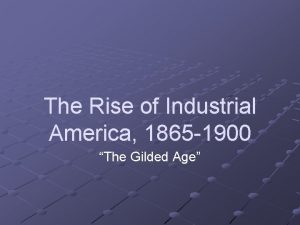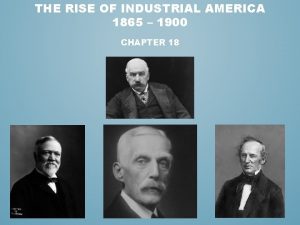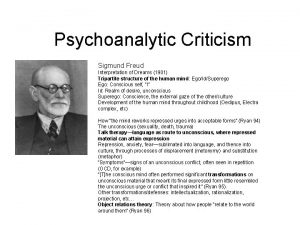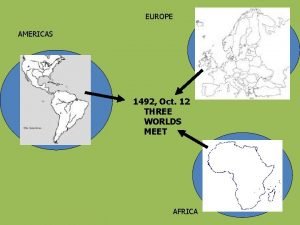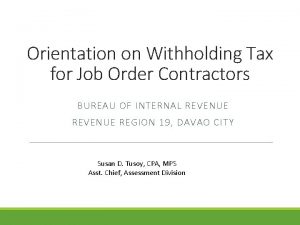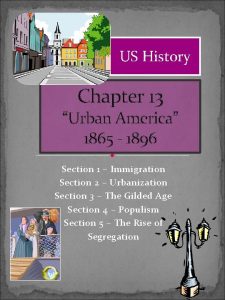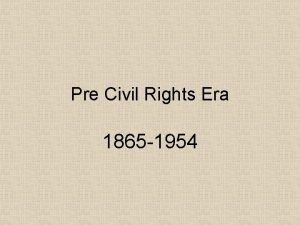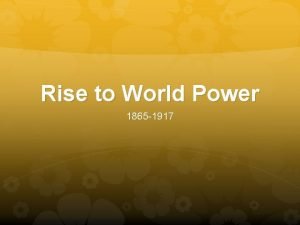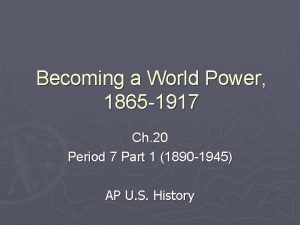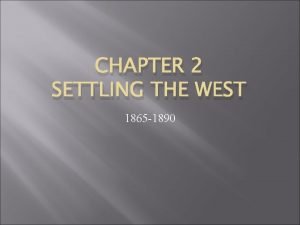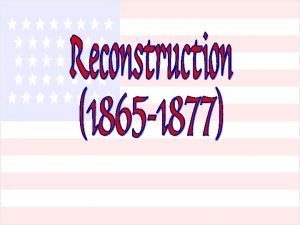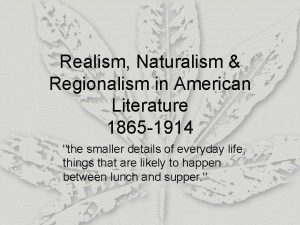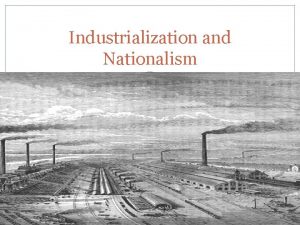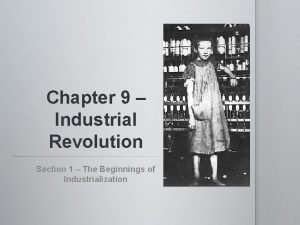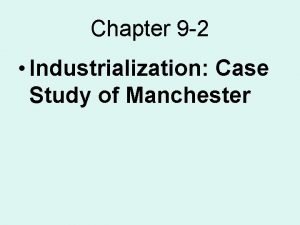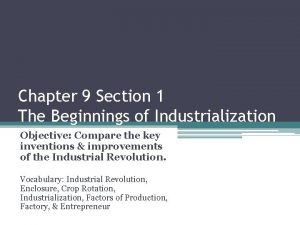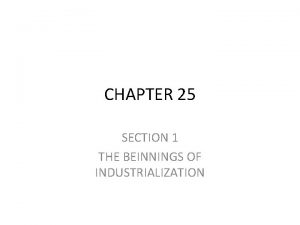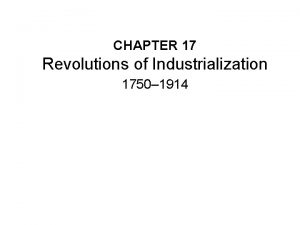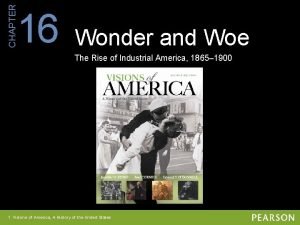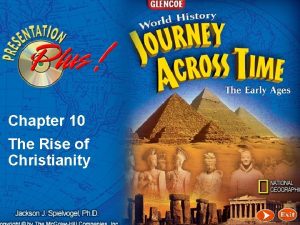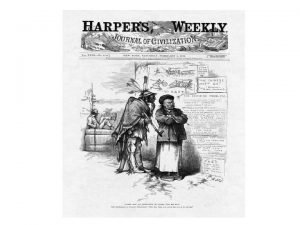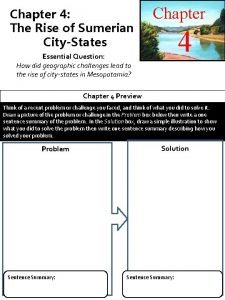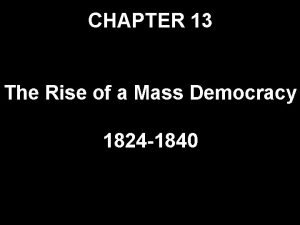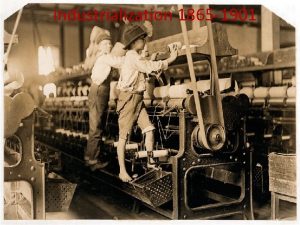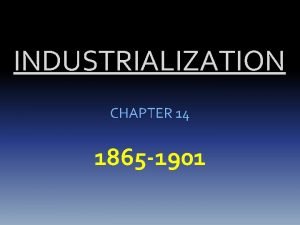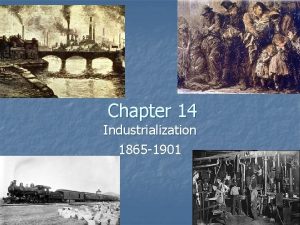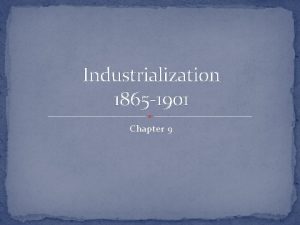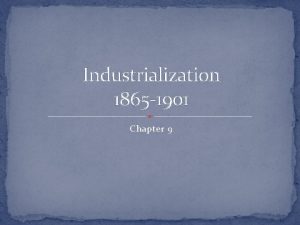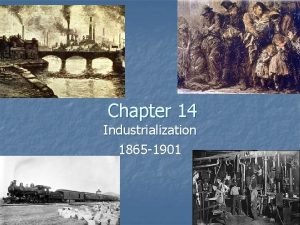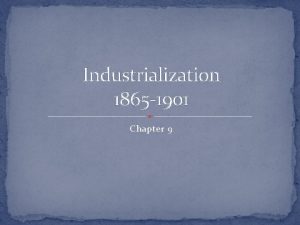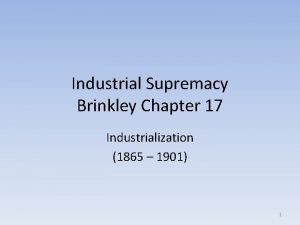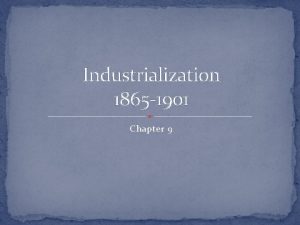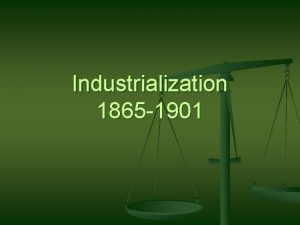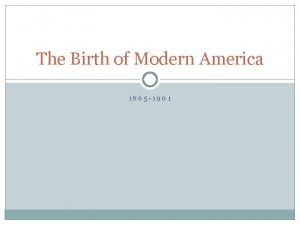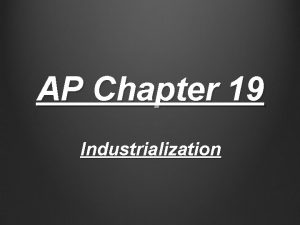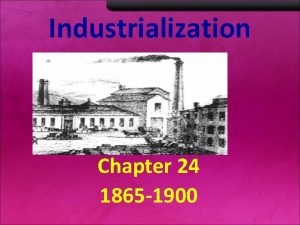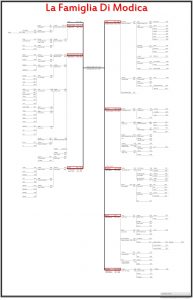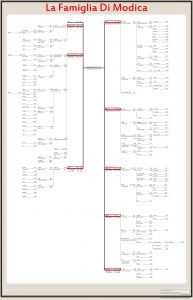INDUSTRIALIZATION CHAPTER 14 1865 1901 The rise of
























































































- Slides: 88

INDUSTRIALIZATION CHAPTER 14 1865 -1901

• The rise of the United States as an industrial power began after the Civil War. • Many factors promoted industry, including cheap labor, new inventions and technology, and plentiful raw materials. • Government policies encouraged growth and large corporations became an important part of the economy. • As industry expanded workers tried to form unions to fight for better wages and working conditions.

UNITED STATES INDUSTRIALIZES • The Industrial Revolution began in the United States in the early 1800 s. • With the end of the Civil War, American industry expanded and millions of people left their farms to work in mines and factories. • By the early 1900 s, the United States had become the world’s leading industrial nation.

• By 1914 the nation’s gross national product (GNP) was eight times greater than it had been when the Civil War ended. What is the gross national product? • The total value of all goods and services produced by a country. • The Gross National Product (GNP) is the total dollar value of all final goods and services produced for consumption in society during a particular time period. • Its rise or fall measures economic activity based on the labor and production output within a country.


WHAT WAS ONE OF THE REASONS FOR THE NATION’S INDUSTRIAL SUCCESS? • An abundance of raw materials. • What were the natural resources found in the United States that led to the country’s industrial success? • Water, timber, coal, iron and copper • At the same time what new resource began to be exploited what was this resource? • Petroleum

WHY WAS PETROLEUM IN HIGH DEMAND? • It could be turned into kerosene. What was kerosene used for? • Used in lanterns and stoves • In 1859 who drilled the first oil well near Titusville, Pennsylvania? • Edwin Drake • By 1900 oil fields from Pennsylvania to Texas had been opened. • As oil production rose it fueled economic expansion.

• Between 1860 to 1910 the population of the United States tripled. • What were the two causes did the population growth stem from? • Large families and flood of immigration. • American industry began to grow at a time when the social and economic conditions in China and Europe convinced many to leave in search for a better life.

WHAT WAS ANOTHER IMPORTANT FACTOR THAT ENABLED THE UNITED STATES TO INDUSTRIALIZE SO RAPIDLY? • Free enterprise • In the 1800 s many Americans embraced the idea of what which meant “let the people do as they choose? ” • Laissez-faire • What did the supporters of laissez-faire believe? • Government should not interfere with the economy other than to protect private property rights and maintain peace.

• Laissez-faire relies on supply and demand rather then the government to regulate prices and wages. • Supporters claim that a free market with competing companies leads to greater efficiency and creates wealth for everyone. • Supports low taxes to ensure that private individuals will make most of the decisions about how the nation’s wealth is spent. • They also believed that the government’s debt should be kept limited since money the government borrows from banks is not available to be loaned to individuals for their use.

• In the United States profit motive attracted people of high ability and ambition into business. • There were those willing to take a risk with their capital to organize and run a business what was this group of people called? • Entrepreneurs • In the late 1800 s entrepreneurs were attracted to manufacturing and transportation fields. • As a result hundreds of factors and thousands of miles of railroads were built.

WHY WAS EUROPE AN IMPORTANT SOURCE OF CAPITAL? • Foreign investors saw more opportunities for growth and profit in the U. S. than at home. • In the late 1800 s state and federal government had a laissez-faire attitude by keeping taxes and spending low and by not imposing regulations on industry. • The government did not control wages or prices. • It adopted policies to help industry.

• Since the early 1800 s the northeastern states and southern states debated on economic polices. • Northerners wanted high tariffs to protect their industries from foreign competition. • Southerners opposed tariffs to keep the cost of imported goods down. • The high tariffs contradicted laissez-faire policies and harmed many Americans.

• As the United States raised tariffs on foreign products, other countries responded by raising tariffs against American products. • American companies who sold goods overseas, especially farmers were hurt by these high tariffs. • Many business leaders and members of Congress felt tariffs were necessary to protect American industry against the already established European factories. • By the early 1900 s, American industries were larger and highly competitive.

WHAT WERE SOME PROBLEMS CAUSED BY HIGH TARIFFS? • When other countries placed high tariffs against American goods it hurt American companies selling products overseas. • Rural American farmers were especially hard hit by the tariffs causing many of them to leave farms and take factor jobs.

NEW INVENTIONS • New inventions increased America’s productivity which in turn produced wealth and job opportunities. • What areas would these new inventions improve? Transportation, communications which was vital to the nations industrial growth. • Led to the founding of new corporations which produced new wealth and new jobs.

• The clothing industry increased productivity in the mid-1800 s with the introduction of the Northrop automatic loom, the power driven sewing machine and cloth cutter. • Mass production in the shoe industry allowed large factories to produce shoes more cheaply and efficiently than local cobblers. The savings then resulted in lower prices.

• Technology improved connections among people. • In 1866 Cyrus Field laid a telegraph cable across the Atlantic Ocean providing instant contact between the United States and Europe.

GUGLIELMO MARCONI • Guglielmo Marconi, an Italian inventor, proved the feasibility of radio communication. • He sent and received his first radio signal in Italy in 1895. • By 1899 he flashed the first wireless signal across the English Channel. • In 1902 he sent the first telegraph from England to Newfoundland. This was the first successful transatlantic radiotelegraph message. • The radio became common in American homes in the 1920 s.

ELISHA OTIS (1852) Elisha Otis, a descendant of revolutionary patriot James Otis (1725 -1783), was born near Halifax, Vermont. He left his family's successful farm at the age of nineteen to pursue a number of trades, including carpentry in Troy, New York, and grist milling, followed by carriage manufacturing and sawmilling in Vermont. In 1845 Otis moved his family to Albany, New York, where he worked as a master mechanic at a bedstead factory and invented an automatic lathe.

In 1851 Otis went to Bergen, New Jersey, and then to Yonkers, New York the following year to supervise the construction of a new bedstead factory for his employer. While in Yonkers, Otis designed a "safety hoist" to lift loads at the factory; his crucial innovation was a safety catch that kept the car from falling if the lifting cable or rope broke.

Otis set up a small elevator shop in Yonkers in 1853, selling only a few for hoisting freight. To increase sales, Otis dramatically demonstrated his elevator during an exhibition at the Crystal Palace in New York City in 1854, riding in the cab high above onlookers and then having the cable cut. This did attract attention, and in 1857 Otis installed the first passenger safety elevator in a New York department store, and later his passenger elevator made the skyscraper feasible. Just before his death, Otis patented a steam-driven elevator, which was the basis for what became the Otis Elevator Company, run by Otis's two sons, Charles and Norton. Among other devices Otis patented were railroad car brakes (1852), a steam plow (1857), and a bake oven (1858).

George Mortimer Pullman 1831– 97, American industrialist and developer of the railroad sleeping car. As a young man he became a cabinetmaker, and after he moved (1858) to Chicago he began converting (1859) old railroad coaches in order to facilitate long-distance traveling. Some five years later he built, the first modern sleeping car. Gaining great wealth from his invention, he founded (1867) the Pullman Palace Car Company. The town of Pullman, now part of Chicago, was built (1880) for the company and its workers. One of the most famous of all U. S. strikes was that at Pullman in 1894.

Thaddeus Sobieski Coulincourt Lowe (August 20, 1832 - January 16, 1913), also known as Professor T. S. C. Lowe, was an Civil War aeronaut, scientist and inventor. Lowe became a pioneer in the field of aeronautics, with the goal of building a trans Atlantic airship. After the war, he experimented with the cooling properties of compressed gases and developed a Carbon Dioxide cooled commercial ice-making machine, for which he was granted British Patent No. 952. His commercially produced ice was first sold in Dallas, TX in 1866.

ALEXANDER GRAHAM BELL Alexander Graham Bell, American inventor and teacher of the deaf, most famous for his invention of the telephone. Since the age of 18, Bell had been working on the idea of transmitting speech. In 1874, while working on a multiple telegraph, he developed the basic ideas for the telephone. His experiments with his assistant Thomas Watson finally proved successful on March 10, 1876, when the first complete sentence was transmitted: "Watson, come here; I want you. ".

In 1874, New York City installs an electric streetcar system designed by Stephen Dudley Field. The system is dangerous and ineffective, but it is a sign of major changes to come in urban transportation.

THOMAS ALVA EDISON Thomas Alva Edison was the most prolific inventor in American history. He amassed a record 1, 093 patents covering key innovations and minor improvements in wide range of fields, including telecommunications, light bulb electric power, sound recording, motion pictures, primary and storage batteries, and mining and cement technology.

James Ritty In 1871, Ritty became a saloon owner in Dayton. Unfortunately for Ritty, some of his employees stole money from the business. In 1878, while on a ship bound for Europe, Ritty saw a machine that counted the number of times that the ship's propeller completed a revolution. Using the same sort of technology, Ritty became convinced that he could invent a machine that could keep track of his sales. He returned to the United States, and with the assistance of his brother, a mechanic, he invented the first cash register.

He patented his invention on November 4, 1879, and called it "Ritty's Incorruptible Cashier. " Ritty's machine did not have a cash drawer. Instead, it simply recorded the number of sales and also the amount of each one. This machine allowed Ritty to keep accurate track of the number of sales and the amount of each sale that was made.

JAN E. MATZELIGER Inventor of the shoe-lacing machine, Jan Matzeliger not only revolutionized the shoe industry but made Lynn, Massachusetts, the "shoe capital of the world. " Born in South America, Matzeliger at eighteen came to the United States to work in a shoe factory where he conceived of a machine that would do the work of more than a dozen workers. The Industrial Revolution had produced machines to cut, sew, and tack shoes, but none had been perfected to automatically stitch the leather of the shoe to the sole. Matzeliger's patented shoe-lasting device drastically reduced shoe prices, increased wages, and improved working conditions for millions who worked in the shoe industry.

• Granville T. Woods was known as the "Black Edison”- invented more than a dozen devices to improve electric railway cars and many more for controlling the flow of electricity.

CHARLES AND FRANK DURYEA America's first gasoline powered commercial car manufacturers were two brothers, Charles Duryea (1861 -1938) and Frank Duryea. The brothers were bicycle makers who became interested in gasoline engines and automobiles. On September 20 1893, their first automobile was constructed and successfully tested on the public streets of Springfield, Massachusetts. Charles Duryea founded the Duryea Motor Wagon Company in 1896, the first company to manufacture and sell gasoline powered vehicles. By 1896, the company had sold thirteen cars of the model Duryea, an expensive limousine, which remained in production into the 1920 s.


OTHER INVENTIONS Air Brake- George Westinghouse Electric Voting Machine- Thomas Edison Cable Street Car- Andrew S. Hallide Carpet Sweeper- Melville Bissell Electric Iron- Henry W. Seely Fountain Pen- Lewis E. Waterman Electric Welding Machine- Elihu Thomas Safety Razor with throwaway blades-King C. Gillette Motor driven vacuum cleaner- John Thurman

LINKING THE NATION 2 • After the Civil War, railroad construction dramatically expanded. • In 1862 President Lincoln signed the Pacific Railway Act which provided for the construction of a transcontinental railroad by the Union Pacific and Central Pacific railroad companies. • To encourage rapid construction the government offered each company land along its right of way.

• In 1865 the Union Pacific under the engineer Greenville Dodge pushed westward from Omaha, Nebraska. The laborers faced blizzards in the mountains, scorching heat in the desert and Native Americans. • What sort of people did the work on the railroad? • Civil War veterans, new immigrants from Ireland, farmers, miners, cooks, and ex-convicts.

• Four merchants known as the “Big Four” invested in the Central Pacific Railroad. • They each bought stock in the railroad and eventually made a fortune. • One of them Leland Stanford became the governor of California founded Stanford University and later became a United States Senator.

“BIG FOUR” • Theodore Dehone Judah sold railroad stock to his declining Central Railroad Company to four merchants • Charley Crocker- Shop Owner • Mark Hopkins- Hardware Store Owner • Collis P. Huntington- Hardware Store Owner • Leland Stanford- Grocery Store Owner

BECAUSE OF THE LABOR SHORTAGE THE CENTRAL PACIFIC HIRED ABOUT 10, 000 _____ WORKERS. Chinese

RAILROADS SPUR GROWTH • Railroads encouraged the growth of American Industry. • The transcontinental railroad was the first of many lines to crisscross the nation after the Civil War. • In the early 1800 s most railways served only local needs, resulting in many unconnected rail lines.

• One of the most famous and successful railroad consolidators was Cornelius Vanderbilt, a former steamboat captain who built the largest steamboat fleet in America. • By 1869 Vanderbilt had purchased and merged three short New York railroads to form the New York Central. • He was the first to offer direct rail service from New York to Chicago.

• In 1883 rail service became safer and more reliable when the American Railway Association divided the country into four times zones or regions, where the same time was kept. • Large integrated railroad systems provided increased efficiency a decrease in time spent in long distance travel and it united Americans from different regions.

LAND GRANT SYSTEM • Building and operating railroads lines especially across the vast unsettled regions of the West often required more money that most private investors could raise on their own. • To encourage railroad construction what did the federal government do? • Gave railroads land grants- land given to railroads by federal government to sell to settlers, real estate companies and other businesses to raise money they needed to built railroads.

ROBBER BARONS • The wealth of railroad entrepreneurs led to accusations that they had acquired their wealth through illegal means. • One of the entrepreneurs with the worst reputation was Jay Gould who used information he obtained as a railroad owner to manipulate stock prices to his benefit.

• Railroad investors realized they could make more money through land grants than by running a railroad so many investors bribed members of Congress to vote for more land grants. • In 1872 corruption in the railroad system became public with the Credit Mobilier scandal. • Several stockholders of the Union Pacific set up the Credit Mobilier a construction company.

• Not all of the entrepreneurs were corrupt. • James J. Hill built the Great Northern Railroad without any federal land grants or subsidies. • It became the most successful transcontinental railroad and the only one not to go bankrupt.

3 BIG BUSINESS • After the Civil War, big business assumed a more prominent role in American life. • By the 1900 big business dominated the economy of the United States. • Big business would not have been possible without the corporation.

• What is a corporation? • A corporation is an organization owned by many people but treated by law as though a single person. • A corporation can own property, pay taxes make contracts and sue and be sued. • The people who own corporations are called what? • Stockholders

• The people who own the corporation own shares of the ownership called what? • Stocks • Issuing stock allows a corporation to raise large sums of money but spreads out the financial risk. • From the sale of stock, corporations could invest in new technologies to increase their efficiency.

• All businesses have two kinds of cost what are they? • Fixed costs- are the costs a company has to pay whether it is operating or not. • Examples of fixed cost- loans, mortgages, and taxes.

• Operating cost- are costs that occur when a company is in operation. • Examples- wages, shipping charges, and supplies. • Big corporations had an advantage over small manufacturing companies. • Big corporations could produce more cheaply, and they could continue to operate even in poor economic times by cutting prices to increase sales. • Many small businesses with high operating costs were forced out of business.

THE CONSOLIDATION OF INDUSTRY • Competition between corporate leaders caused lower prices for consumers, but it also cut into profits. • To stop prices from falling, companies organized pools or agreements to keep prices at a certain level. • Pools usually did not last long. • As soon as one member cut prices, the pool broke apart. • By the 1870 s, competition had reduce industry to a few large highly efficient corporations.

• Andrew Carnegie a poor Scottish immigrant worked his was up from a bobbin boy in a textile factory to the president of the Pennsylvania Railroad. • He invested much of his money in railroad-related businesses and later owned his own business. • He opened a steel company in 1875 and quickly adapted his steel mills to use the Bessemer Process. Started at a $1. 20 a week, worth close to 2 billion at his death.

• Carnegie began the vertical integration of the steel industry. What is a vertical integration company? • A company which owns all the different businesses it depends on for operation. • This not only saves money but also makes a big company bigger.

Ace Meat Industries Delivery Vehicles Meat Packing Plants Cooled Warehouses Refrigerated Rail Cars Slaughterhouse Cattle VERTICAL INTEGRATION COMPANY

• Business leaders also pushed for horizontal integration- combining many firms doing the same business into one large corporation. • A monopoly occurs when one company gains control of an entire market. • In the late 1800 s, Americans became suspicious of large corporations and feared monopolies. • Many states made it illegal for a company to own stock in another company without permission from the state legislature.

Purchase of Competing Companies in Same Industry HORIZONTAL INTEGRATION U. S. Oil Company Independent Oil Refineries

MONOPOLY

• In 1882 Standard Oil formed the first trust, which merged businesses without violating laws against owning other companies. • A trust allows a person to manage another person’s property. • A holding company did not produce anything itself. • Instead it owned the stock of companies that did produce goods. • The holding company controlled all the companies it owned, merging them all into one large enterprise.

WHY DID AMERICANS FEAR MONOPOLIES? • Americans feared monopolies because a company with a monopoly could charge whatever price it wanted for a product.

SELLING THE PRODUCT • Retailers looked for new ways to market and sell their goods. • Advertising changed with illustrations replacing small-type line ads. • N. W. Ayer and Son of Philadelphia developed bold new formats for advertising.

• The department store changed the idea of shopping by bringing in a huge assortment of products in a large glamorous building. • Chain stores like Woolworth’s focused on offering low prices instead of special services or fancy décor.

• Mail-order catalogs were created to reach rural Americans. • Montgomery Ward and Sears, Roebuck were two largest catalog retailers.

HOW DID DEPARTMENT STORES CHANGE THE IDEA OF SHOPPING? • Department stores brought a huge assortment of products into one building. • They made shopping seem glamorous and exciting.

4 JOHN D. ROCKEFELLER • By the 1880 s the Standard Oil Company, under the direction of John D. Rockefeller and his associates had gained control of more than 90% of the oil refining business in the United States.

UNIONS In an attempt to improve their working conditions industrial workers came together to form unions in the 1800 s.

• Life for workers in industrial America was difficult. • Dangerous working conditions and the income difference between the wealthy and the workers caused resentment. • Between 1865 and 1897 the United States experienced deflation or a rise in the value of money. • Relations between workers and employers were made more difficult by deflation.

EARLY UNIONS • Two types of workers were part of industrial America. • Craft workers had special skills and were generally paid more. • Common laborers had few skills and as a result received lower wages. • In the 1830 s craft workers formed trade unions which were unions limited to people with specific skills.

• By 1873 there were 32 trade unions in the United States. • Employers opposed industrial unions which united all craft workers and common laborers in a particular industry. • Companies went to great lengths to prevent unions from forming.

• Companies would have workers take oaths to sign contracts promising not to join unions. • They would also hire detectives to identify union organizers. • Workers who organized a union or strike were fired and put on a what? • Blacklist- What is a blacklist? A list of troublemakers. • Once blacklisted a worker could get a job only by changing trade, residence of his or her name.

• If a union was formed companies used a what? • Lockout • Workers went without pay and were locked out of the property. • If the union did strike employers would hire replacement workers called strikebreakers also known as scabs. • There were no laws that gave workers the right to organize.

• The ideas of Karl Marx was popular in Europe. What was it called? • Marxism • Marx felt it was the class struggle between the workers and the owners that shaped society. • He believed the workers would revolt and gain control. • After the revolution Marx believed a socialist society would be created in which the wealth was evenly divided and classes would no longer exist.

• Many labor supporters agreed with Marxism and some supported the idea of anarchism. • Anarchists believed society did not need government and that a few acts of violence would cause the government to collapse. • As ideas of Marxism and anarchism spread in Europe tens of thousands of immigrants arrived in the United States. • People began to associate Marxism and anarchism with immigrants. They also were suspicious of unions as well.

THE STRUGGLE TO ORGANIZE • Workers attempted to create large unions, but rarely succeeded. • Many times confrontations between owners and government ended in violence. • The Great Railroad strike of 1877 occurred after severe recession in 1873 forced many companies to cut wages.

In the summer of 1877, a nationwide upheaval brought the United States to a standstill, 80, 000 railroad workers stopped work. Hundreds of thousands of other Americans soon followed: men and women, black and white, native- and foreign-born. It was America's first national strike; many observers thought a second American Revolution was at hand.

• The failure of the great railroad strike led to a need for better organized laborers. • By the late 1870 s the first nationwide industrial union called the Knights of Labor was formed.

• They demanded an 8 hour workday a government bureau of labor statistics equal pay for women, an end to child labor and worker-owned factories. • They supported arbitration a process where an impartial third party helps mediate between workers and management. • The Haymarket Riot caused the popularity of the Knights of Labor to decline

• A nationwide strike was called to show support of and eight-hour workday. • A clash in Chicago left one striker dead. • The next evening a meeting at Haymarket Square was scheduled to protest the killing. • Someone threw a bomb-in the end 7 police and 4 more workers were killed. • No one knew who threw the bomb yet one man from the Knights of Labor was arrested.

• The riot would hurt the reputation of the union and people started to drop out. • In 1893 railroad workers created the American Railroad Union (ARU) • They unionized the Pullman Palace Car Company in Illinois. • After recession caused the company to cut wages, a boycott of Pullman cars occurred across the United States. • It tied up the railroads and threatened the economy.

• To end the boycott U. S. mail cars were attached to Pullman cars. • Refusing to handle a Pullman car would result in tampering with the mail a violation of federal law. • After an injunction or formal court order stopped the boycott the strike and the ARU both ended.

THE AMERICAN FEDERATION OF LABOR • In 1886 delegates from over 20 of the nation’s trade union organized the American Federation of Labor.

• The AFL’s first leader was Samuel Gompers whose plain and simple approach to labor relations helped union become accepted. • Gompers wanted to keep unions out of politics and to fight for small gains such as higher wages and better working conditions.

• Under Gompers leadership the AFL had three goals: to get companies to recognize unions and agree to collective bargaining to pushed for closed shops where companies could only hire members and to promote an eight-hour workday. • By 1900 s the AFL had over 500, 000 members. • The majority of workers however were still unorganized.

MARY HARRIS “MOTHER” JONES • By 1890 Jones had become an organizer for the Union Mine Workers.

WORKING WOMEN • By 1900 women made up more than 18% of the labor force. • Women worked as domestic servants, teachers, nurses, sales clerks and secretaries. • Women were paid less than men. • It was felt that men needed a higher wage because they needed to support a family.

• Most unions excluded women. • A separate union for women was created by Mary Kenney O’Sullivan, Leonora O’Reilly. Jane Addams and Lillian Waldthe founders of the settlement house movement and helped to form the Women’s Trade Union League.

• The WTUL pushed for an eight hour day, the creation of a minimum wage and end to evening work for women and the abolition of child labor. • The WTUL also collected funds to support women on strike.

THE END
 Industrialization (1865 to 1901 worksheet answers key)
Industrialization (1865 to 1901 worksheet answers key) Industrialization (1865 to 1901 worksheet answers key)
Industrialization (1865 to 1901 worksheet answers key) The rise of industrial america 1865-1900
The rise of industrial america 1865-1900 The rise of industrial america 1865-1900
The rise of industrial america 1865-1900 Rise and rise until lambs become lions
Rise and rise until lambs become lions Tricky dick
Tricky dick Rise again and again until lambs
Rise again and again until lambs A union b example
A union b example The victorian age 1832 to 1901 unit test
The victorian age 1832 to 1901 unit test 1837-1901
1837-1901 Victorian period
Victorian period 1896 1901
1896 1901 Freud 1901
Freud 1901 British empire 1901
British empire 1901 Poblogaeth cymru 1971
Poblogaeth cymru 1971 Bir form 1901 job order
Bir form 1901 job order 1901 n. moore street
1901 n. moore street The victorian period (1832–1901)
The victorian period (1832–1901) Numberblocks 1901
Numberblocks 1901 Victorian age 1832 to 1901
Victorian age 1832 to 1901 Dula sa panahon ng amerikano
Dula sa panahon ng amerikano Urban america 1865 to 1896
Urban america 1865 to 1896 Hollywood silver fox farm v emmett
Hollywood silver fox farm v emmett 1954-1865
1954-1865 Becoming a world power 1865-1917
Becoming a world power 1865-1917 Monet
Monet Becoming a world power 1865-1917
Becoming a world power 1865-1917 Soddie
Soddie Al cruzar una planta de guisantes de flores purpura
Al cruzar una planta de guisantes de flores purpura How did renoir glamorize his clientele
How did renoir glamorize his clientele 1877-1865
1877-1865 Realism naturalism and regionalism
Realism naturalism and regionalism 1865 to 1900 inventions
1865 to 1900 inventions Industrialization spreads chapter 9 section 3
Industrialization spreads chapter 9 section 3 Chapter 9 section 3 industrialization spreads
Chapter 9 section 3 industrialization spreads Chapter 9 section 3 industrialization spreads answer key
Chapter 9 section 3 industrialization spreads answer key Lesson quiz 23-2 industrialization and nationalism answers
Lesson quiz 23-2 industrialization and nationalism answers Industrialization and nationalism lesson 1
Industrialization and nationalism lesson 1 Chapter 10 industrialization and nationalism
Chapter 10 industrialization and nationalism The beginnings of industrialization chapter 9 section 1
The beginnings of industrialization chapter 9 section 1 Chapter 9 section 2 industrialization case study manchester
Chapter 9 section 2 industrialization case study manchester The beginnings of industrialization chapter 9 section 1
The beginnings of industrialization chapter 9 section 1 Chapter 25 section 2 industrialization
Chapter 25 section 2 industrialization Chapter 17 revolutions of industrialization
Chapter 17 revolutions of industrialization Chapter 13 the rise of totalitarianism
Chapter 13 the rise of totalitarianism Qiyamm
Qiyamm Chapter 10 section 1 guided reading the rise of islam
Chapter 10 section 1 guided reading the rise of islam Chapter 6 section 3 the rise of christianity answer key
Chapter 6 section 3 the rise of christianity answer key Chapter 13 the rise of a mass democracy
Chapter 13 the rise of a mass democracy Chapter 10 the rise of christianity
Chapter 10 the rise of christianity The rise of industrial america chapter 16
The rise of industrial america chapter 16 Chapter 10 the rise of christianity
Chapter 10 the rise of christianity Chapter 4 lesson 5 the rise of segregation
Chapter 4 lesson 5 the rise of segregation Chapter 4 the rise of sumerian city-states
Chapter 4 the rise of sumerian city-states The rise of fascism worksheet answers
The rise of fascism worksheet answers The rise of islam chapter 10 section 1
The rise of islam chapter 10 section 1 Chapter 13 the rise of a mass democracy
Chapter 13 the rise of a mass democracy Hát kết hợp bộ gõ cơ thể
Hát kết hợp bộ gõ cơ thể Frameset trong html5
Frameset trong html5 Bổ thể
Bổ thể Tỉ lệ cơ thể trẻ em
Tỉ lệ cơ thể trẻ em Gấu đi như thế nào
Gấu đi như thế nào Tư thế worm breton là gì
Tư thế worm breton là gì Chúa sống lại
Chúa sống lại Các môn thể thao bắt đầu bằng tiếng đua
Các môn thể thao bắt đầu bằng tiếng đua Thế nào là hệ số cao nhất
Thế nào là hệ số cao nhất Các châu lục và đại dương trên thế giới
Các châu lục và đại dương trên thế giới Công của trọng lực
Công của trọng lực Trời xanh đây là của chúng ta thể thơ
Trời xanh đây là của chúng ta thể thơ Mật thư anh em như thể tay chân
Mật thư anh em như thể tay chân 101012 bằng
101012 bằng Phản ứng thế ankan
Phản ứng thế ankan Các châu lục và đại dương trên thế giới
Các châu lục và đại dương trên thế giới Thể thơ truyền thống
Thể thơ truyền thống Quá trình desamine hóa có thể tạo ra
Quá trình desamine hóa có thể tạo ra Một số thể thơ truyền thống
Một số thể thơ truyền thống Cái miệng nó xinh thế chỉ nói điều hay thôi
Cái miệng nó xinh thế chỉ nói điều hay thôi Vẽ hình chiếu vuông góc của vật thể sau
Vẽ hình chiếu vuông góc của vật thể sau Thế nào là sự mỏi cơ
Thế nào là sự mỏi cơ đặc điểm cơ thể của người tối cổ
đặc điểm cơ thể của người tối cổ V cc
V cc Vẽ hình chiếu đứng bằng cạnh của vật thể
Vẽ hình chiếu đứng bằng cạnh của vật thể Fecboak
Fecboak Thẻ vin
Thẻ vin đại từ thay thế
đại từ thay thế điện thế nghỉ
điện thế nghỉ Tư thế ngồi viết
Tư thế ngồi viết Diễn thế sinh thái là
Diễn thế sinh thái là Dot
Dot
